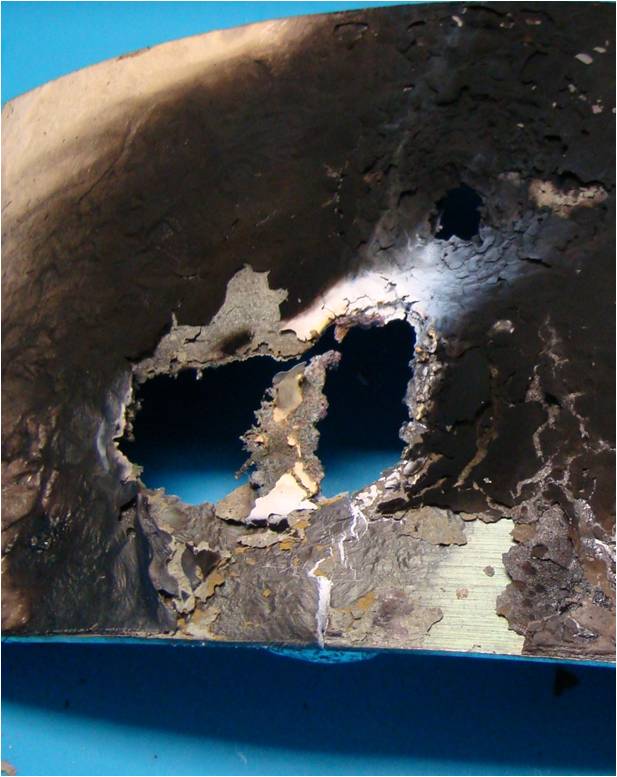Northrop Grumman has test fired the first product in its next-generation FIRESTRIKE family of high-energy, solid-state lasers that meet goals for size and weight reduction and ruggedization for operational applications.
The tests, conducted in the company’s Redondo Beach laboratory, demonstrated that the laser could burn through the skin and critical components of a target drone used to simulate anti-ship cruise missile threats to U.S. Navy ships.
The laser, called Gamma, uses a “slab” architecture similar to previous Northrop Grumman high-power lasers. It operated at 13.3 kilowatts for a number of shots over a total of 1.5 hours with stable performance and a beam quality that exceeded design goals, completing the initial phase of trials.
“We previously announced the design for a product called FIRESTRIKE that builds on our heritage of record-breaking, high-energy, solid-state lasers. Since that time we’ve invested our internal funds to fabricate, integrate and test a demonstration prototype of the FIRESTRIKE laser that we call Gamma,” said Steve Hixson, vice president of advanced concepts, space and directed energy systems for Northrop Grumman’s Aerospace Systems sector.
“Gamma has equaled or exceeded the performance we achieved in previous slab lasers, but the real advancement here is in packaging and ruggedization for operations in real-world military platforms,” he added. The term “slab laser” refers to a class of high-power, solid-state lasers with a gain medium, or source of atoms that emit light, in the form of a slab about the size of a microscope slide.
“The Gamma demonstrator is built in a form factor that implements the size and weight reduction goals of the FIRESTRIKE design, which cuts the weight of the finished laser chain to 500 pounds and shrinks the volume to 23 inches by 40 inches by 12 inches, or about the size of two countertop microwave ovens,” said Dan Wildt, vice president, directed energy systems, Northrop Grumman Aerospace Systems.
“This laser has also been ruggedized to demonstrate how robust operational FIRESTRIKE lasers can be,” Wildt said.
“Our company has more than 50,000 lower power laser devices in operation with the Defense Department. “We applied lessons from those systems to be sure this laser will be able to survive in real-world operational environments and keep operating reliably.”
“Gamma implements a significant reduction in the number of internal optical components, while new mounting techniques eliminate sensitivity to vibrations. Key portions of the Gamma laser have already been subjected to vibration, shock and thermal testing to validate that these improvements have achieved design goals,” said Wildt.
The Gamma demonstrator is a single “chain” or building block that is designed to be combined with other chains to create laser systems of greater power, as was demonstrated in Northrop Grumman’s 105 kilowatt Joint High Power Solid State Laser.
“This hallmark for company lasers allows them to be combined coherently, meaning they retain their good beam quality, or the ability to focus energy at long ranges, even as more power is added,” Wildt explained.
“The Gamma laser was tested at a beam quality of 1.4, which beat the design goal of 1.5, and we expect it to keep improving. A perfect beam quality is 1. Owing to its excellent beam quality, the 13.3 kilowatt Gamma is also brighter than its design goal, meaning it can put more power on target at range.”
The lethality testing used a single Gamma chain at short distance in a way that simulated the effects that a laser weapon of several chains aboard a Navy ship could achieve at a range of several miles. “We validated that the laser could produce the amount of energy we predicted, and that the energy would have the effect on the target that we predicted,” said Wildt.
The components used in the test included the skin of a surplus BQM-74 drone and other parts configured to represent critical internal components. The BQM-74 was formerly produced by Northrop Grumman for the Navy as a representative cruise missile threat and used for testing defensive systems.
“The FIRESTRIKE laser, announced in 2008, forms the backbone near-term laser weapon systems from Northrop Grumman. Combined with advanced electro optical and/or infrared sensors, FIRESTRIKE line replaceable units and their subsystems can provide military services with active defense, offensive precision strike and enhanced situational awareness capabilities, all in the same weapon system,” Wildt said.










